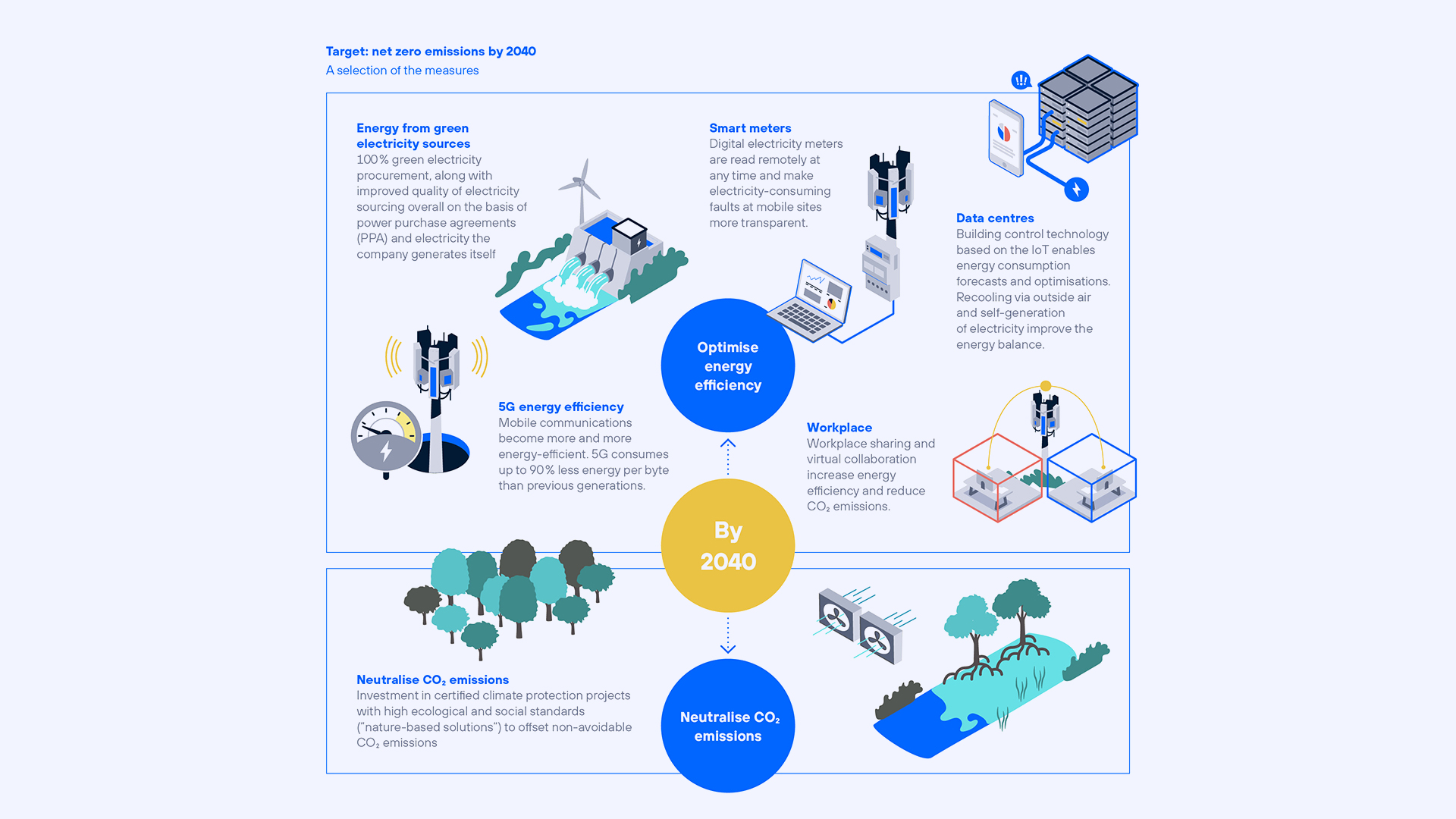Climate responsibility
Digitalisation can reduce carbon emissions

Digitalisation can play a decisive part in advancing climate protection as, according to a Bitkom study, millions of tonnes of carbon emissions can be eliminated with smart grids in the energy infrastructure, Internet of Things applications in industry, telecommuting and smart mobility solutions. However, the increase in the volume of data transmitted via the networks as part of this ongoing digitalisation requires additional electricity, which in turn influences the environment and climate.
O2 Telefónica answer to this is to reduce power consumption per byte with energy-efficient mobile communications standards and technical modernisations. By 2025 the company aims to reduce energy consumption per data volume by 87 % compared with 2015. The expansion of the 5G network will be crucial here as 5G requires up to 90 % less power per transported byte than previous generations.
As of today, O2 Telefónica already purchases 100 % green electricity at all locations. With Power Purchase Agreements (PPA), the Telefónica Deutschland Group invests directly in renewable energies and increases the planning security for its energy supply.
The commitment: net zero carbon emissions by 2040

“We aim to achieve net zero CO2 emissions in our own operations by 2025 at the latest, and net zero emissions along our entire value chain by 2040. We want to at least reduce and ideally avoid carbon emissions and only offset those which are absolutely unavoidable. We want to use less and less electricity per byte to transport the significantly increasing data volumes that go hand in hand with digitalisation.”
Markus Haas
Chief Executive Officer (CEO)
Chief Executive Officer (CEO)
The climate strategy of O2 Telefónica is a comprehensive concept that combats climate change and is a key component of the sustainability management. The company set itself the target of net zero emissions by 2040.
By 2025, emissions in Scope 1 and 2 as well as emissions from travel activities are to be neutralized. By 2040 at the latest, greenhouse gas emissions in the entire value chain (Scope 3) will be reduced to net zero. Scope 3 emissions, e.g. from the supply chain, will be evaluated in a coordinated manner across the entire Telefónica, S.A. Group, and measures will be taken to reduce them. The Group’s target here is to reduce its carbon emissions by 39% by 2025 (base year: 2016).
The focus of O2 Telefónica's efforts is on carbon dioxide (CO2). However, the two greenhouse gases methane (CH4) and nitrous oxide (N2O) and the climate-relevant cooling gases (F-gases) are also taken into account. The reductions are presented in carbon equivalents (CO2e) as the unit of measurement.
In adopting the term “net zero emissions”, O2 Telefónica is following the findings and recommendations of recognised international institutions such as the Intergovernmental Panel on Climate Change (IPCC) and the Science Based Targets initiative (SBTi), according to which it has developed its climate strategy.
The climate targets of the company are therefore in line with the recommendations and demands made in the field of science – global warming is to be limited to 1.5°C compared with pre-industrial levels. O2 Telefónica therefore aligns its ambitions closely with the climate protection targets of Telefónica, S.A., which has made a Group-wide commitment to achieving net zero emissions.
Unavoidable emissions are neutralized by purchasing high-quality CO2 reduction projects, preferably projects that remove CO2 from the atmosphere.
What O2 Telefónica is doing concretely

Target: net zero emission by 2040
Energy efficiency and CO2 reduction are at the heart of O2 Telefónica's climate strategy: the company invests in energy-efficient technology, uses green electricity, promotes low-emission mobility and increasingly offers its customers sustainable products and services. Companies and people can realise their sustainable digital business models with the help of O2 Telefónica's infrastructure and offers and thus contribute to protect the environment.
O2 Telefónica labels business products and services that make a significant contribution to reducing energy, CO2 and water consumption and/or promote the circular economy with the “Eco Smart seal". Consumers can use the “Eco-Rating” to find out about the environmental impact of the entire process of manufacturing, using and disposing of a smartphone.
Network technology is responsible for around 99% of O2 Telefónica's electricity consumption. The measurement of electricity consumption is already carried out at many locations via smart metering systems. The consumption of each mobile phone system equipped with a smart meter is recorded every second and transmitted to a cloud server via the O2 network using an Internet-of-Things radio unit. Subsequently, when threshold values are exceeded, an analysis of the power consumption across all sites is to take place, which enables predictive maintenance and makes malfunctions identifiable at an early stage. Thanks to this real-time data, energy consumption can be better managed.
The company also sees great potential in the virtualisation of data centres, as the efficiency of data centres is related to their utilisation and the possibilities of waste heat utilisation, among other things. There is a shift from Scope 2 to Scope 3 emissions in this area due to greater use of cloud services and the resultant switch to external providers. The company wants to use cloud services efficiently and reduce emissions to a minimum. Migration to the cloud additionally offers advantages in terms of scalability and the resource-conserving use of computing capacity.
Latest News







